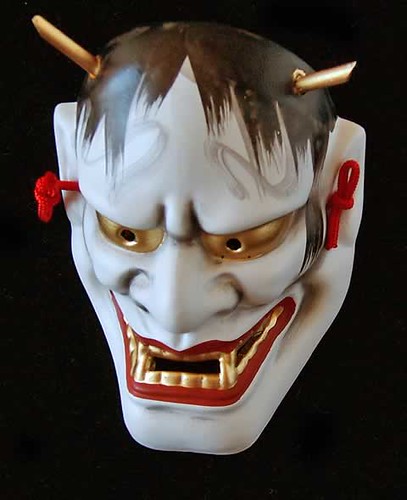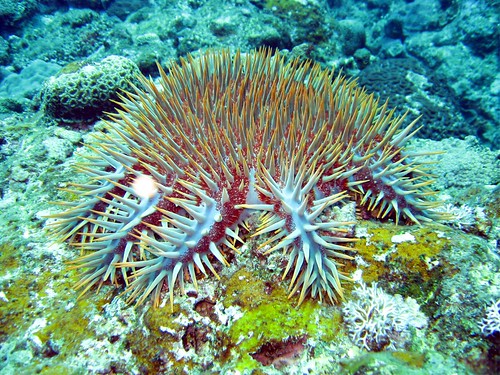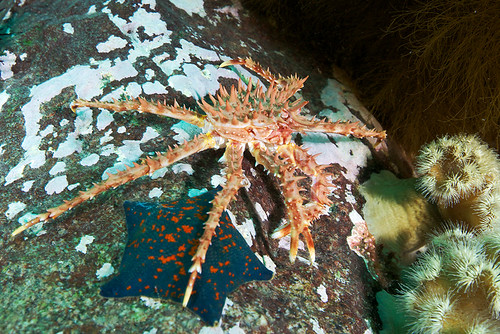My research over the last few years has taken me not only to Japan but also gotten me interested in the nomenclature of various Japanese starfish species!!
Although many of these are essentially common names, they are surprisingly standardized and are widely recognized in addition to the western Latin names. While studying these I also encountered a few other cool stories about invertebrates which have been part of Japanese folklore and myth.
So this week: The Invertebrate-Japanese folklore connection! Names & monsters/spirits inspired by invertebrates!!
I thank Matt Alt of AltJapan and Dr. Toshihiko Fujita of the National Museum of Nature & Science for providing me with some of the the information in today's post!
1. The Oni Hitode
So, the term yokai (妖怪) refers to a spirit or ghost , most of which have a strong root in Japanese folklore and myth. There are a great MANY types, some of which are listed here and Wikipedia of course! Perhaps one of the types of yokai which I see popularly presented in pop culture and literature and in some Western sources is a demon called an Oni, of which one face is represented below...
The spines on the head are a characteristic feature of this yokai. Its this characteristic which has most likely been lent to Acanthaster planci, the crown of thorns starfish which is known in Japanese as the Oni Hitode or "Demon starfish" 鬼ヒトデ
In 2008, there was a Japanese campaign to celebrate the International Year of the Reef and the Oni Hitode was made into a kawaii or Japanese cartoon character called the Oniide
Here's another kawaii I found of the Oni-hitode, which from what I understand was part of a"Kill the crown of thorn starfish" campaign. Acanthaster planci, is a fairly well known predator of coral and has been undergoing massive population booms leading to frequent efforts to remove them.
 |
| From this Japanese site |
And of course, the inevitable transformation of the crown of thorns starfish into a kaijin or "human sized" monster to be defeated by a snorkel-adorned Kamen Rider!
2. Higuruma Hitode (or not?)
Another cool Japanese starfish name is one this deep-sea brisingid starfish, Brisingaster robillardi.
I've described brisingid sea stars at length here. Deep-sea species which feed on prey in water currents using "velcro" (tiny claws) on their spines. More great images of these animals here.

The common name for this species is called the Higuruma Hitode which sounds GREAT! Hitode is Japanese for starfish. But What is a "Higuruma"??
Higuruma is apparently one name for a ghost/yokai called Kasha (whose name apparently translates to "flaming chariot" who carts the corpses of sinners off to the underworld (thanks to Matt Alt for this info). I suppose in this case the "corpses of sinners" are represented by small crustacean prey! Muahaha!
The resemblance between the flames (the arms) emerging from the wheel (the disk) is how this starfish was likely named! Pretty neat!
 |
| Image from Dr. Fujita |
To give you a better idea, here is a very similar "fire wheel" type yokai called Wanyudo, which translates to "wheel monk" and who apparently steals the souls of those who gaze upon it. Apparently many yokai can be similar in appearance
It also shows the "flames from wheel" appearance that this starfish takes after...
 |
| Image via the Yokai Attack! FB group |
3. The Sazae-oni aka the "Snail Ogre" 栄螺鬼
This yokai is apparently one of the more malevolent ones and according to Yokai.com is a dangerous spirt that pretends to be a beautiful drowning woman in order to lure and feed on sailors.
There's a whole mythology about these yokai which involves pirates and monsters biting off their testicles. You can read the colorful version here.
 |
| Image by Toriyama Sekien via wikipedia and also this Japanese site |
These yokai are actually based on horned turban snails, Turbo cornutus which look like this
These snails in Japan are called sazae (hence the name "snail demon"and are eaten throughout Japan, often grilled in their own shell
This species of snail is widely familiar to the Japanese and was even made into a kaiju called Gogo in the show Ultra Q, the precursor to Ultraman!
4. Hekigani ヘイケガニ The "samurai crabs"(the crab Heikeopsis japonica)
This "ghost" is actually more of a ghost story. It basically relates the story of this crab, Hekeopsis japonica which often have a very human-like face on their carapace (i.e., the top side of the skeleton).
But here's a gorgeous painting which shows this event in various stages..
 |
| Image by Utagawa Kuniyoshi via Wikipedia |
4a. The Kani-Oni: DEMON CRAB!!
While doing research for this post I came across this creature, the Kani oni! aka the Crab Demon. I couldn't find out much about it, but I did realize one thing..
Thereare only THREE pairs of legs per side. This is a characteristic feature of lithod crabs, which are actually more closely related to hermit crabs. "Proper crabs" such as the Japanese spider crabs have 4 legs on each side.
But this species is very similar to this species, Lithodes aequispina (unconfirmed ID). Thus, the ghost crab does seem to be something in the Lithodidae.
The spines on the crab might allude to another species of lithode crab which has bigger and more prominent spines on the carapace, such as this one.
And as long as we are talking about crustaceans.. let's not forget all the cool things about Japanese giant isopods -Bathynomus doderleini and kin! aka the オオグソクムシ The common names of giant isopods are named for samurai armor!
So this particular ghost isn't actually based on an invertebrate..but it gets honorable mention..
The name Umibozu translates to "Ocean or Sea, Buddhist Monk" and have been explained as the ghosts of drowned buddhist monks. They are apparently haunted spirits of the ocean and mentioning their name invokes bad luck for ships at sea.
From all the accounts that I could find, there are apparently different "morphotypes" of what Umibozu look like with some images looking a bit more of a human shape...
The Umibozu tend to be rarely seen and considered somewhat mysterious..
I happened to notice a curious coincidence between these and Opisthoteuthis, aka one of the "dumbo octopuses"! But nah.. the umibozu are FAR more menacing!
NEXT WEEK: NUDIBRANCHS!


















3 comments:
As a fan of youkai, invertebrates, and Halloween, I highly approve of this article.
Could you do an article on polychaetes sometime? I adore these beautiful creatures, but hardly anyone talks about them :(
I have several posts about polychaetes
http://echinoblog.blogspot.com/search?q=polychaete
but none which combine polychaetes and Japanese mythology! thanks for your kind words!
This blog is so tremendous! I stumbled upon it searching the names of Japanese starfish and you have a great writing style!!!
Post a Comment